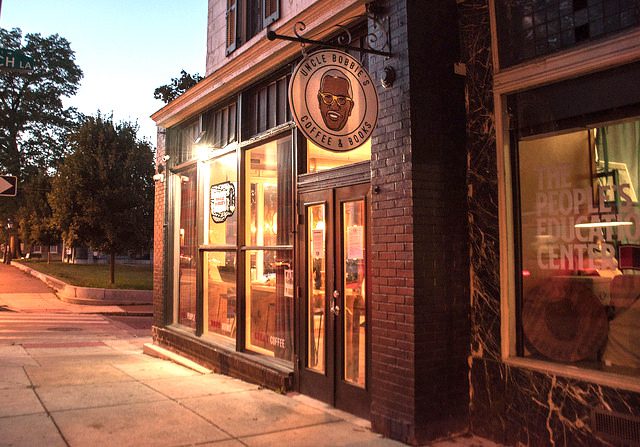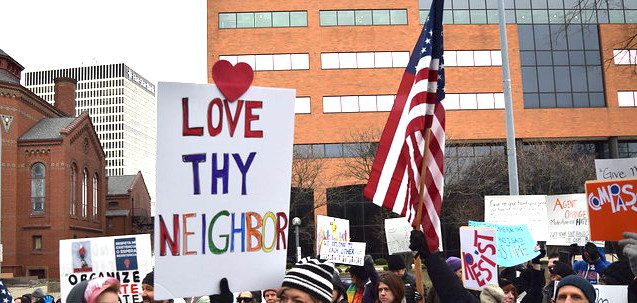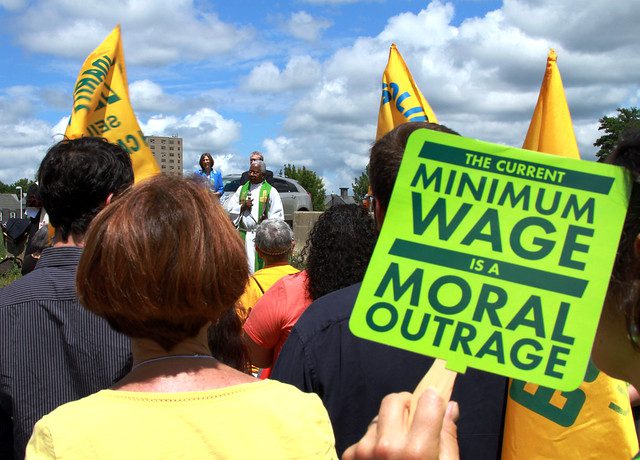
Uncle Bobbie’s Coffee & Books in Germantown, PA. Photo by Joe Piette via flickr, CC BY-NC-SA 2.0.
Quote of the week:
“In the midst of an affordable housing crisis, with homeownership rates at near record lows, this plan makes no sense.” —Jesse Van Tol of NCRC condemns Sen. Mike Crapo’s (R-Idaho and Senate Committee Banking chair) GSE proposal, announced today, to drop its affordable housing goals and Duty to Serve rule.
Coffee shops, especially certain chains, are often associated with cultural displacement in appreciating neighborhoods. But they don’t have to be. Billy Penn describes a cadre of Black-owned coffee shops in Philadelphia that succeed in being consistent, welcoming places for longtime neighborhood residents to gather.
Report Review: The Regional Affordable Housing and Fair Housing Roundtable, which includes placed-based community developers and fair housing advocates from the New York City metro area, has released a joint policy agenda. The report, called Closing the Divide: Creating Equitable, Inclusive, and Affordable Communities, is notable for its boldness—it includes a call for New York State to develop a fair share affordable housing policy, with some thoughtful details about how it might work—and its comprehensiveness, covering topics from tenants rights to increasing density to school integration. It’s also refreshing in its honesty: there is one controversial policy proposal in the city (resident preference) that the group did not agree on, and rather than shying away from it, the report explores the topic head on and acknowledges the issues it raised. Even for those not from New York, it’s worth a read.
Distressed communities’ need for climate resilience is beyond critical. The Federal Reserve’s conclusion two years ago that 40 percent of U.S. households do not have the means to cover a $400 emergency expense caused researchers at the University of North Carolina’s Center for Urban and Regional Studies to revisit their own 2014 study of the state’s most economically distressed tracts. Comparing their maps with FloodzoneData, they found that those distressed areas are largely located in 100- and 500-year flood zones.
The 2008 foreclosure crisis has left behind vacant property problems in possibly unexpected places, such as St. Petersburg, Florida, a small city that was nearing 800 vacant properties before a recent turnaround. The area is still a desirable place to live however, with land cost being one of the major obstacles to affordable housing construction, the mayor told Governing magazine. So an aggressive campaign of tax foreclosure aimed at absentee landlords and zombie properties (and more unusually, even some preemptive purchases at auction to keep bad actors from entering the market) has enabled the city to reduce vacancies by 75 percent and turn over a lot of land to affordable housing developers. It’s a great model where the market is strong enough, though it won’t carry over quite the same to hypervacant areas.
The country’s low birth rate has been attributed to many things, but a recent CityLab article suggests that zoning laws—like one Philadelphia city councilwomen’s now-defunct proposal that sought to ban new daycare centers in northwest Philadelphia—may impact accessibility to and affordability of the housing, services, and facilities average families need. Whether it’s restrictive zoning, family-unfriendly design, or the stress of high housing costs, none of these things create an environment that make it any easier to start or raise a family.
Seattle is among a handful of cities infamous for its well above-average housing costs, which may be in part why its city council voted this week to place a one-year moratorium on the redevelopment of a mobile home park slated for sale. Residents of the park, one of only two remaining in Seattle and housing a large number of lower-income seniors and disabled people, went to a city council meeting this week and appealed successfully to members. The city council will begin working on long-term protections for mobile home residents, and an idea now on the table for that park is selling it to a mobile home park operator rather than a developer.
We love to come across articles about the social determinants of health in mainstream media. The more people talk and write about it, the more we can help communities become healthier and happier. This piece in Politico focuses on the need to have more funding directed to social services, as this would do more for our national health than money invested directly in health care.
New York City plans to completely eliminate childhood lead poisoning by inspecting every apartment annually, reducing the amount of lead in paint and dust that requires remediation, and increasing health resources for any child who does test positive. It’s great to see such an all-in effort, especially knowing there was a time when fighting against childhood lead poisoning wasn’t an easy thing to do.
There’s a really interesting piece in The New York Times about the housing crisis and technology. The article focuses on whether the right tech ideas could solve the problem, and why technology hasn’t yet fixed challenges related to housing affordability.
Enterprise has launched a five-year, $250 million initiative to create healthier communities by bringing the health and housing sectors together to preserve affordable homes. The initiative, dubbed Health Begins with Home, will “promote health as a top priority in the development and preservation of affordable homes and . . . elevate homes as an essential tool for improving resident and community health.”





Comments